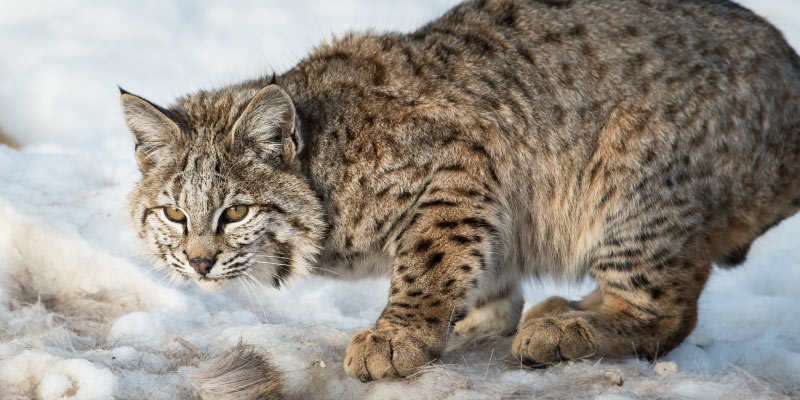
Large predator sightings often create a buzz in cities, towns, and between neighbors. Warnings to keep pets inside are issued and mutterings about safety are heard. Professor Adrian Treves, who has been studying large predators for the past few decades, says these worries are often just “crying wolf.” Treves and the Carnivore Coexistence Lab hope to increase a positive public perception of large carnivores as they study the behavioral ecology between predators and humans. Read on to learn more about Treves, predator perceptions, and why wolves, bears, and big cats are crucial to a healthy environment.
Starting off with a hard-hitting question, what is your favorite large carnivore?
I really love big cats, but I’ve been pulled back into the wolf world repeatedly despite efforts to get out of it. And I love bears, too. So, I guess I don’t have a single favorite of the carnivores — the whole order of mammals, especially the big ones, fascinate me.
What does field work look like for you? Do you ever work directly with large carnivores?
It’s been years since my students or I have handled a large carnivore, and that’s because they’re wild and we want to keep them that way. So, we use indirect methods for detecting them such as trail cameras, following tracks, or collecting scat or hair. Those are all indirect methods, which means the precautions we need to take are just the ordinary ones that a hiker might have to take in the back country, like pepper spray. We have never had a close call, and I want to emphasize that those are infinitesimally rare hazards. For example, taking a car to our field site is much more dangerous statistically.
Why are large predators important for the environment?
Large predators play a disproportionate role in their ecosystem, as in, they influence a great number of species more than the average animal. That’s because large predators affect a number of prey animals, and then leave their carcasses on the landscape, which helps scavengers. Their population control helps stop herbivores from overeating the vegetation, and our forests become healthier, have more mature structure, regenerate faster, and are more resistant to non-native plant species invasions.
On top of that, we’re getting some intriguing results that top predators reduce the prevalence of wildlife diseases. This all has to do with how predators will eat over-abundant prey animals, or they will specifically target the sick prey animals. A third reason to have top predators around is that there are less vehicle collisions with deer in counties that contain wolves. So, if you put all those things together, you get a very compelling case that we need to maintain the top predators in our ecosystems, restore them to where they were eradicated, and not worry about them overpopulating because they regulate their own densities.
How does the public generally react to large carnivore sightings?
People attach quite a lot of importance to the sighting of a large carnivore. It’s usually rare, and it’s exciting. Some people react negatively, others react positively, but it has a lot of importance to both sides. Often, the reactions are disproportionate to the risk. This whole idea of keeping your pets inside when a bear is sighted across town is actually exaggerating the risk to your pets. I’m not saying people should be flippant about it, but there’s typically zero risk. And sometimes it can be a disproportionately positive reaction where someone sees a bear and half the people in town might rush to go see it because they’re excited about it. Then, that might disrupt the bear’s behavior and cause some strange reactions.

What are some trends in the relationship between large predators and humans?
Scientifically, we’ve studied it with people over the age of 18 living inside and outside of wolf range from 2001 to 2013. Those trends in attitudes suggested a decline in tolerance for wolves, particularly among men living within wolf range who are familiar with hunting. Attitudes amongst women remained stable, and the Ojibwe people, who are major legal actors, were generally very positive toward wolves. The decline in attitudes appears to us to be associated with an increase in the killing of wolves, as well as a government message that there are too many wolves and that they’re causing costs and conflicts.
On the other hand, anecdotally, year after year as I lecture on wolves, I get the sense that young people are increasingly positive about wolves. So, I think there’s a generational difference. Our surveys measured the same people since 2001 as they got older, whereas there’s an influx of younger folks that generally have a more positive attitude towards wolves. I’m optimistic that wolves will be allowed to recolonize their native range, bringing those benefits to people and to ecosystems, and that there’ll be fewer people who are intolerant of them.
What’s something you want the general public to know about large predators?
The public should be aware that lethal methods, although they’re widely used, are actually failing scientific tests of effectiveness. The tradition is for livestock owners to kill predators that pose a threat to their animals. There’s increasing evidence that that’s not protecting livestock for a variety of reasons. One possibility is when you break up a wolfpack with lethal methods, the pack becomes less effective, and the survivors turn to domestic animals out of desperation. Another possibility is when we kill large predators, we’re leaving vacancies that get filled by a greater number of newcomers who are going to cause more problems for us.
The second thing I’d love readers of this to be aware of is that wildlife is a public trust asset, which means it belongs to the public, including future generations. It doesn’t belong to a narrow interest group or subset of hunters, anglers, or trappers. When the public becomes aware of this, they should step up and assert their rights to have wildlife managed in the way they like, not a narrow interest group that just wants to kill them.